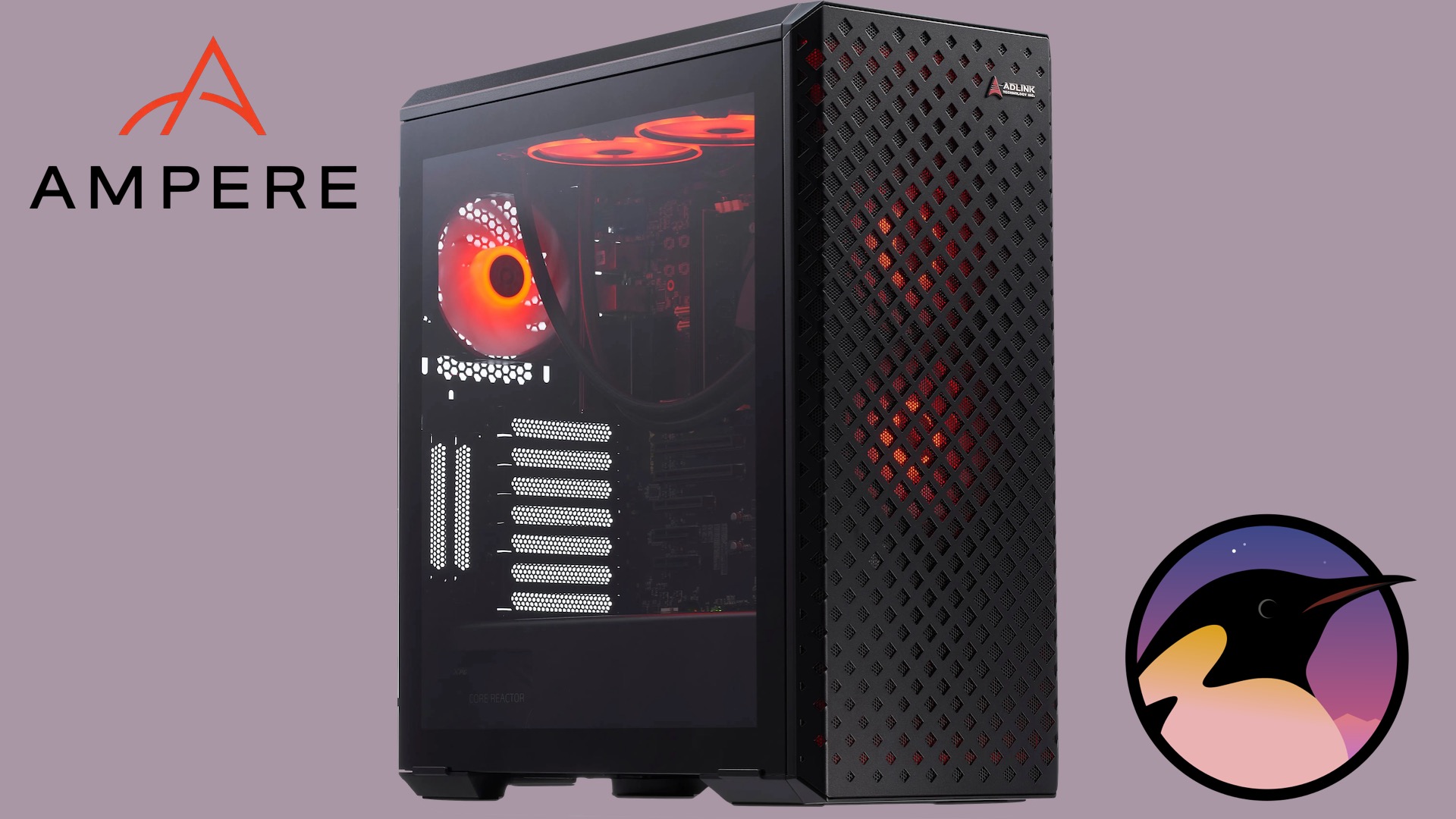Linus Torvalds now favors Ampere Arm chip over Apple Silicon MacBook for building Linux kernels — says he's now doing more Arm64 Linux testing than ever
Ampere's powerful Arm CPUs give the developer a hand in Linux testing

Linux kernel creator Linus Torvalds has recently upped his game in testing Arm64 Linux. He initially began Arm64 Linux builds on an Apple Silicon MacBook Air, but now, thanks to a more powerful Ampere AArch64 system, he’s doing even more Arm64 testing.
Torvalds, known for creating not just the Linux kernel but also Git, worked exclusively on Intel hardware for years. Then, he switched to an AMD Ryzen Threadripper workstation for his main system. When he got his hands on his MacBook, he routinely used it to compile new Arm64 kernel builds.
Beginning with Linux kernel 5.19, Torvalds was compiling Arm64 builds on a 2022 MacBook Air with Apple’s M2 System-on-a-Chip (SoC). That model only includes 8 CPU cores, though. When Linux 5.19 was released, Torvalds wrote that he was “trying to make sure that the next time I travel, I can travel with this as a laptop and finally dogfooding the Arm64 side, too.”
In his release notes for the Linux 6.9 build, Torvalds explained that since he has “a more powerful arm64 machine (thanks to Ampere),” he’s now doing “almost as many arm64 builds as I have x86-64.”
The developer now has an Ampere workstation/server with a high number of Armv8 cores. Torvalds doesn’t specify which Ampere system he has, but some believe it to probably be some variant of the Ampere Altra family.
Yes, the AmpereOne supports more CPU cores, but Altra workstations are more readily available. With support for up to 128 cores, the Ampere Altra is certainly robust enough for heavy-duty Arm64 Linux testing.
Torvalds explained that he expects he will continue doing quite a few Arm64 Linux builds going forward. He’s still using the M2 MacBook but explained that it’s more for weekly test builds than a daily driver. The daily driver is, presumably, the Ampere system he cited in the release notes.
Get Tom's Hardware's best news and in-depth reviews, straight to your inbox.
We’ve contacted Torvalds to ask which Ampere workstation or server he’s using and will update you with any response.

Jeff Butts has been covering tech news for more than a decade, and his IT experience predates the internet. Yes, he remembers when 9600 baud was “fast.” He especially enjoys covering DIY and Maker topics, along with anything on the bleeding edge of technology.
-
ezst036 Has an Ampere Altra ever been benchmarked directly counter ---> Apple ARM? Most likely the M2? (for timing/release date reasons)Reply
Having so many many more cores, I can see why that sort of parallelism would be useful when doing kernel compiling. I shudder to even contemplate how much $$ Apple would charge for a chip with 128 CPU cores in it. Yikes! -
DS426 Linus is surprisingly eccentric for the person that he his (or what he has established and accomplished, rather). Even when Apple Silicon performance was like the holy grain of ARM performance, getting an Apple device was truly a spit-in-the-face for the ENTIRE Linux and even broader FOSS community. Sorry, but making a deal with the devil is... just that, lol. Sure, basically the perfect ARM-based mobile platform from a raw specs/performance standpoint (and I mean including battery life, being lightweight and thin, etc.), but what did they really net him and the grander Linux community?? Really, serious question!Reply
Fortunately, nVidia wasn't allowed to acquire ARM and although they would have made some beastly aarch64 CPU's, the free world was spared some time. And while seeing ARM rise up against the x86 monarchy is great, I'd love to see more RISC-V adoption outside of China. As for Apple... I don't think they'll see that large of a perf gain as they did, with M3, M4, etc. just being incremental gains and requiring that next "quantum leap" in technology to really move the needly. Even if they do, they are still Apple a.k.a. f the rest of the computing ecosystem and those that believe in a technology world that involves more than one freaking vendor/manufacturer. Sounding like a hater but I really can overstate the danger of these monopolies and oligopolies, ESPECIALLY when much to most of the vertical integrations are owned by the same company. It's not even academic; we know what the robber-barons, the Rockefellers and Carnigies and JP Morgans did so long ago and how long it took to break up those empires. FFS, the U.S. federal government is finally tired of Apple's control and therefore is finally ligitating against them. Microsoft needs it as well, to be clear... -
bit_user Reply
Altra is based on a server version of the Cortex-A76 cores that now grace the Raspberry Pi 5. It's a 4-way issue core, whereas I think M2's P-cores are 8-way (if not more). Also, the M-series are cache-heavy, while Altra has less cache per core than its x86 contemporaries. Considering Apple's other optimizations, it's pretty safe to say the M2 is easily twice as fast, core-for-core.ezst036 said:Has an Ampere Altra ever been benchmarked directly counter ---> Apple ARM? Most likely the M2? (for timing/release date reasons)
Where the Altra really wins is on simple core-count. Also, the amount of memory bandwidth it managed to squeeze from 8x DDR4-3200 was pretty impressive.
I guess what surprises me most is that this didn't happen like 2 years ago. You could already buy Altra workstations, back then, and they weren't teetering precariously on the brink of obsolescence, like they are now. -
bit_user Reply
I feel weird for defending him on this point, because I agree with you in that I wouldn't buy an Apple device purely on principle. But, Linus got it because there's an unofficial community port of Linux for it. Don't think for a second that he actually ran MacOS on it!!DS426 said:Even when Apple Silicon performance was like the holy grain of ARM performance, getting an Apple device was truly a spit-in-the-face for the ENTIRE Linux and even broader FOSS community.
Grace is already pretty beastly, especially if you have two of them as a 144-core "superchip", on one SXM board.DS426 said:Fortunately, nVidia wasn't allowed to acquire ARM and although they would have made some beastly aarch64 CPU's,
ARM is a cult? He's sure not writing code for MacOS!jkflipflop98 said:LOL Linus. A loser writing crap code for a cult. -
Pierce2623 Reply
I can’t understand why people can’t see that the Zuckerbergs and Musks, and Bezos(s?) and Altmans (maybe even the Huangs and Sus) of the world are absolutely every bit as dangerous and corrupt as the Rockefellers or Carnegies were.DS426 said:Linus is surprisingly eccentric for the person that he his (or what he has established and accomplished, rather). Even when Apple Silicon performance was like the holy grain of ARM performance, getting an Apple device was truly a spit-in-the-face for the ENTIRE Linux and even broader FOSS community. Sorry, but making a deal with the devil is... just that, lol. Sure, basically the perfect ARM-based mobile platform from a raw specs/performance standpoint (and I mean including battery life, being lightweight and thin, etc.), but what did they really net him and the grander Linux community?? Really, serious question!
Fortunately, nVidia wasn't allowed to acquire ARM and although they would have made some beastly aarch64 CPU's, the free world was spared some time. And while seeing ARM rise up against the x86 monarchy is great, I'd love to see more RISC-V adoption outside of China. As for Apple... I don't think they'll see that large of a perf gain as they did, with M3, M4, etc. just being incremental gains and requiring that next "quantum leap" in technology to really move the needly. Even if they do, they are still Apple a.k.a. f the rest of the computing ecosystem and those that believe in a technology world that involves more than one freaking vendor/manufacturer. Sounding like a hater but I really can overstate the danger of these monopolies and oligopolies, ESPECIALLY when much to most of the vertical integrations are owned by the same company. It's not even academic; we know what the robber-barons, the Rockefellers and Carnigies and JP Morgans did so long ago and how long it took to break up those empires. FFS, the U.S. federal government is finally tired of Apple's control and therefore is finally ligitating against them. Microsoft needs it as well, to be clear... -
Pierce2623 Reply
He’s obviously talking about the Linux community when he says “cult”, not a hardware vendor. Also the Grace CPU uses off the shelf ARM cores that are much less potent than Apple core architectures or the new Qualcomm core architecture. Grace is literally just a slightly newer Neoverse core than the Ampere Altra.bit_user said:I feel weird for defending him on this point, because I agree with you in that I wouldn't buy an Apple device purely on principle. But, Linus got it because there's an unofficial community port of Linux for it. Don't think for a second that he actually ran MacOS on it!!
Grace is already pretty beastly, especially if you have two of them as a 144-core "superchip", on one SXM board.
ARM is a cult? He's sure not writing code for MacOS! -
ezst036 Replyjkflipflop98 said:LOL Linus. A loser writing crap code for a cult.
https://www.cultofmac.com/
-
DS426 Reply
Cult of personality, yes -- not the FOSS community though as most are about the concept, not the person.jkflipflop98 said:LOL Linus. A loser writing crap code for a cult. -
bit_user Reply
Okay, whatever. The world runs on Linux... some cult. Just sayin'.Pierce2623 said:He’s obviously talking about the Linux community when he says “cult”, not a hardware vendor.
Yeah, so does Ampere Altra.Pierce2623 said:Also the Grace CPU uses off the shelf ARM cores
But you can't get around the disparity in the number of cores! The kernel source tree has tens of thousands of source files, which is a nearly-perfect workload for a massively multi-core machine. I don't know how many cores his Mac has, but let's say it's 16. For kernel builds, you're way better with 8x as many cores, even if they're only half as fast.Pierce2623 said:that are much less potent than Apple core architectures or the new Qualcomm core architecture.
There's a pretty massive difference between Neoverse V2 vs. N1 cores. I could easily believe it's close to 2x and higher in vector workloads. If you can find a benchmark comparing AWS Graviton 4 vs. Graviton 2, that's effectively what you're talking about.Pierce2623 said:Grace is literally just a slightly newer Neoverse core than the Ampere Altra.